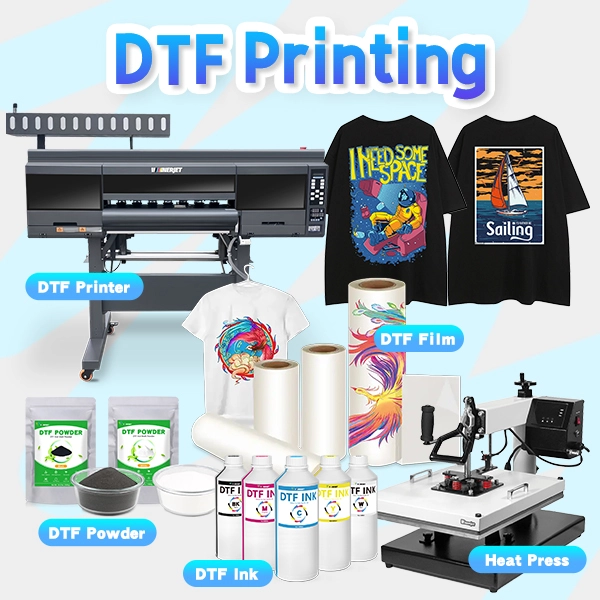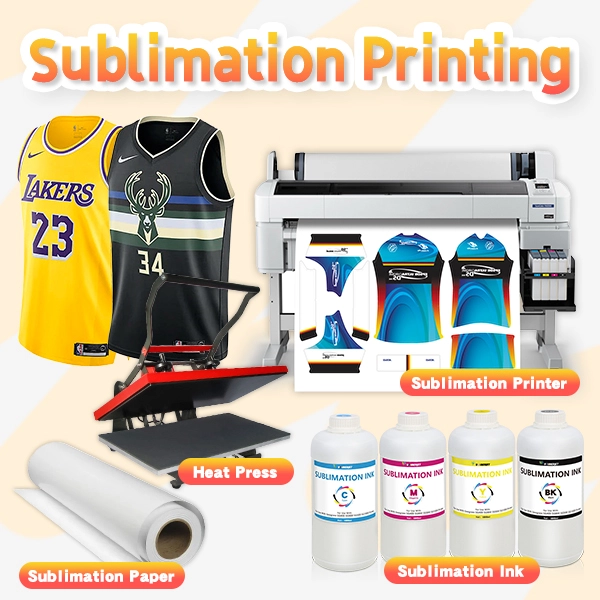DTF printing and Sublimation printing are both popular methods in the market. Whether you are a DIY individual enthusiast or a custom production company, you will be exposed to them.
People often ask: DTF VS Sublimation, what is the difference? Which method is more suitable for my business?
Next, follow this article to fully understand the differences between Sublimation Vs DTF.
What is DTF printing?
DTF printing is an emerging printing technology that operates with simplicity. First, the DTF (Direct Film) printer prints the design onto the DTF film and then uses a heat press to heat and transfer the design pattern on the DTF film to the fabric. If you would like to learn more about DTF printing, be sure to check out our blog “What is DTF Printing“
What is sublimation printing?
Sublimation printing is a digital printing technology. First, a sublimation printer prints the pattern on sublimation paper, and then a heat press transfers the pattern to the substrate surface to obtain a colorful print.For more information on sublimation printing, please check out our guide “What is Sublimation Printing“.
Necessary materials: Sublimation Printer, Sublimation ink, Sublimation Paper.
Specific Comparison: DTF VS Sublimation
Let’s compare the differences between the two printing methods in detail so that it will be easier for you to choose the most suitable method for your printing business.
DTF Printer VS Sublimation Printer
DTF printers use a transfer film to which the ink is printed to create colorful designs, and they usually print faster.
Sublimation printers use sublimation paper to convert the ink into a gas through heat and inject it into the garment.
Compatible Materials
DTF printing can be applied to almost all fabrics such as cotton, polyester, nylon, silk, leather, etc.
Sublimation printing can only be used on light-colored or white polyester fabrics. Or substrates with sublimation coatings.
DTF Printing Steps
- Preparation: Design and save the print pattern in the correct format.
- Printing: Set the printing parameters and print the pattern.
- Coating: Cover the pattern part with hot melt powder and put it in the oven to solidify the powder.
- Transfer: Heat the heat press to 160°C (320°F), put the transfer film on the fabric, and press the heat press for 15-30S with medium pressure.
- Finishing: Tear off the transfer film.
Sublimation Printing Steps
- Design a pattern: Use design software to create and save the pattern.
- Print the design: Use a sublimation printer to print the pattern on sublimation paper.
- Transfer: Use a heat press to transfer the pattern to the target substrate.
Printing Quality
Unlike sublimation printing, DTF printing can produce colorful, long-lasting prints on almost any fabric.
Sublimation printing cannot print white, which limits its printing colors. At the same time, sublimation uses paper transfer, so its printing effect is not as vivid and lifelike as DTF.
Hand Feel
DTF printing is to transfer the pattern to the fabric, and you will feel a layer on the surface of the garment when you touch it.
Sublimation printing is done by evaporating the ink to fuse the pattern and fabric. When you touch it, it feels like touching a blank T-shirt.
Cost
DTF printing will have a higher initial cost. It is cost-effective when producing small batches.
Sublimation printing has a lower initial investment cost, with higher costs for small orders and lower costs for large-scale production.
Market
DTF printing materials are highly compatible and widely used. They can be printed on a variety of fabrics and are very suitable for mass-customized clothing production.
Sublimation printing materials have limitations and are more suitable for the small and medium-sized customized product market, such as sportswear, jerseys, mugs, etc.
Pros & Cons: DTF VS Sublimation Printing
Pros of DTF Printing
- Suitable for any fabric.
- Prints are vivid in color and rich in detail.
- Printed products can be washed more than 60 times without noticeable fading.
- High efficiency, suitable for large quantity orders.
Cons of DTF Printing
- The DTF printing process involves multiple steps and longer production times.
- DTF printing will cover the surface of the fabric and will not feel as good as sublimation printing.
- The equipment and related consumables are more expensive, and the initial investment cost is high.
Pros of Sublimation Printing
- The operation is simple and even a novice can master it quickly.
- Durable, sublimation printing has strong resistance to fading and abrasion.
- The print is soft and blends in with the fabric, contrasting with DTF printing; it feels pleasing.
Cons of Sublimation Printing
- Applicable materials are limited and only suitable for light-colored polyester or items with sublimation coating.
- Dedicated printer and materials have high initial costs.
- Only light colors can be printed, and complex designs with multiple colors may not be printed.
DTF Printing VS Sublimation: Which Is Better?
DTF printing and thermal sublimation printing each have advantages and disadvantages, but the choice depends on your business scope and the needs of your target customers.
If you are still looking for a cost-effective and powerful DTF printer, Winnerjet experts are ready to provide professional advice for your printing business to obtain high-quality prints (T-shirts).
FAQS
Is DTF the same as sublimation?
No, DTF and sublimation are different printing methods.
Can you use sublimation ink on dtf film?
No, sublimation ink is incompatible with DTF film; you can only use special DTF ink.
Can I do DTF with a sublimation printer?
No, sublimation printers are used for the printing sublimation process, and DTF printers are used for making DTF.
Do you use sublimation ink for DTF?
DTF printing can only use special ink to achieve the ideal printing effect.
Does DTF printing last longer than sublimation?
Both prints are very durable, but you need to take care of each piece.




